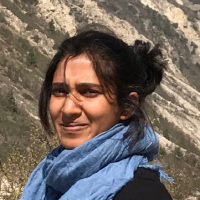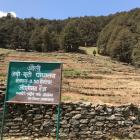In the district of Garhwal in the Indian Himalayas, at 10,000 feet (3,048 meters) above sea level, forests of sycamore, chestnut, and rhododendron gradually give way to gently sloping grasslands. Known locally as bugyals (from the Garhwali word bug for soft grasses), these meadows were the favored grazing grounds of communities of trans-Himalayan traders and their flocks of sheep and goats. High-altitude meadows are home to musk deer, moonal pheasants, and a variety of flowers, grasses (such as the scented jambu), medicinal herbs, and roots (jadi butiyan). Garhwali villagers had long used the jadi butiyan of bugyals for household consumption and trade. Customary restrictions—such as the belief that flowers having medicinal properties, like the Brahma Kamal, should not be plucked before the Nanda Devi fair—made this usage sustainable. The advent of scientific forestry in the princely state of Tehri-Garhwal (the Tehri Durbar), together with the growth of an urban elite Hindu market for Ayurvedic potions, arguably transformed the social lives of Himalayan herbs.
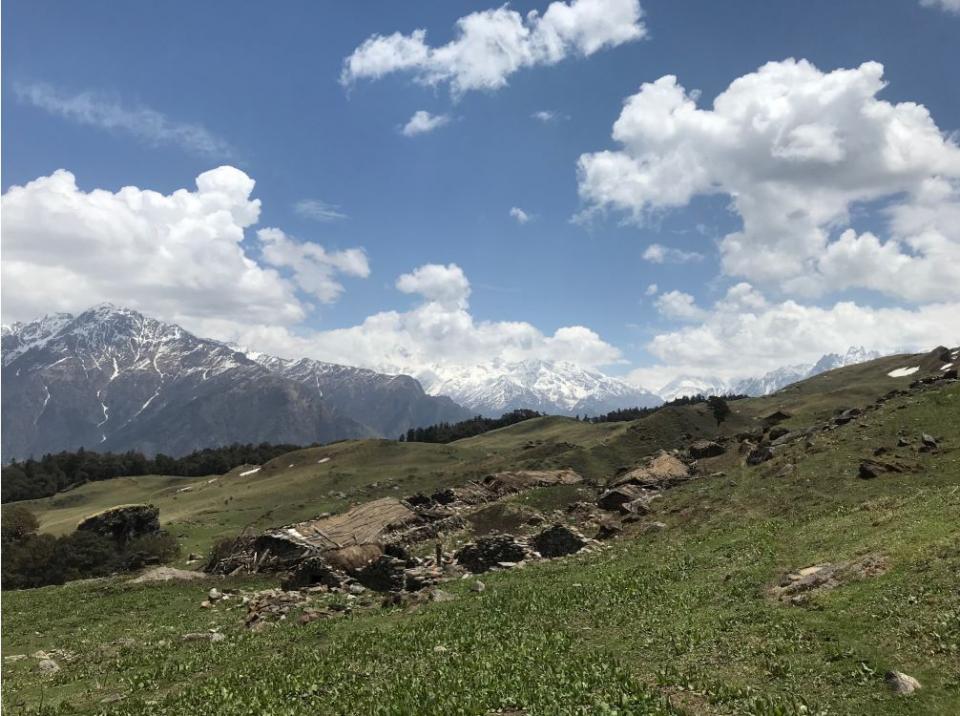
The Gurson Bugyal and the chappars (summer shelters) of seasonal Garhwali shepherds.
The Gurson Bugyal and the chappars (summer shelters) of seasonal Garhwali shepherds.
Photograph by Nivedita Nath
 This work is licensed under a Creative Commons Attribution 4.0 International License.
This work is licensed under a Creative Commons Attribution 4.0 International License.
Historians have argued that modern associations between Ayurveda and “Hinduism” constitute an “invented tradition.” Works by upper-caste elites, such as the Maharaja of Gondal’s Aryan Medical Science (1895), claimed an exclusively “Hindu” provenance for the medicinal practices of Ayurveda. The nationalist reinvention of modern Ayurveda generated a market for medicinal herbs dominated by over a dozen firms by 1910. This emergent urban, “Hindu” bourgeois market for herbal medicines provides the context for the Tehri Durbar’s arguably unique project to commodify Himalayan herbs. Whereas the British government was reluctant to expand the plantation and manufacture of indigenous drugs, the Durbar established a separate department for the purpose, called the Vanaspati Karyalaya, that worked closely with the Forest Department.
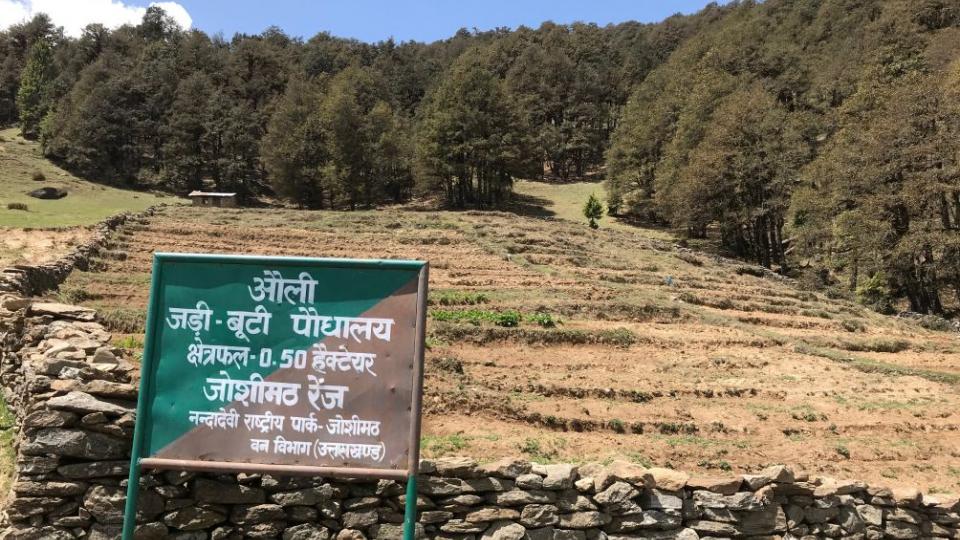
Auli Medicinal Herb Plantation, managed by the Uttarakhand Forest Department, on the fringes of Gurson Bugyal in Eastern Garhwal.
Auli Medicinal Herb Plantation, managed by the Uttarakhand Forest Department, on the fringes of Gurson Bugyal in Eastern Garhwal.
Photograph by Nivedita Nath
 This work is licensed under a Creative Commons Attribution 4.0 International License.
This work is licensed under a Creative Commons Attribution 4.0 International License.
Subordinated to the British government, the Tehri Durbar had begun contracting out vast swathes of pine and deodar forests to timber traders from the mid-nineteenth century onwards. In 1879 the Durbar’s Forest Department demarcated protected Reserved Forests and restricted peasant access to common resources. Restrictions on the sale and collection of forest produce were put in place between 1878 and 1885, under the reign of Pratap Shah, precipitating numerous forest dhandaks (uprisings) as a consequence. Rules governing forest access changed in response to such protests and by 1930 prohibitions on the collection of and trade in medicinal herbs were lifted in certain areas. The foundation of the Vanaspati Karyalaya prompted the systematization of the Forest Department’s initial efforts to monetize the collection of herbs through taxes, contracts, and tenders. By 1927 the department was working with the Karyalaya to carry out the sale of medicinal herbs, such as Gugal, Mashi, Atis, and Kawri, yielding an income of 18,294 rupees. Nevertheless, a quantity of collected herbs remained undisposed of. From the Durbar’s Annual Reports, it appears that though herbs were in demand in domestic and foreign markets, the Karyalaya’s preparation of Ayurvedic medicines seemed to have commanded “ready sale” primarily in the domestic market. Subsequently, therefore, the Forest Department focused on the overall sale and plantation of herbs while the Karyalaya specialized in the processing of herbs.
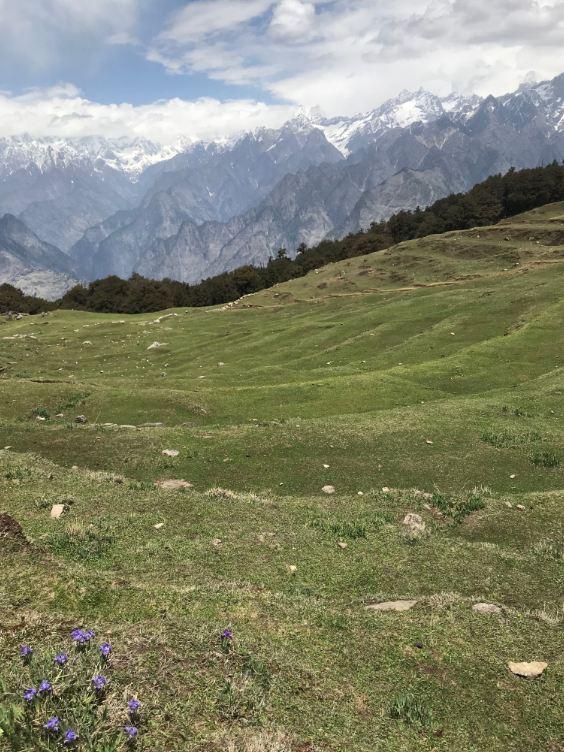
Outline of older terraces used for the cultivation of medicinal herbs by the Forest Department, with a Kumauni iris (one among an array of meadow flowers) in the foreground.
Outline of older terraces used for the cultivation of medicinal herbs by the Forest Department, with a Kumauni iris (one among an array of meadow flowers) in the foreground.
Photograph by Nivedita Nath.
 This work is licensed under a Creative Commons Attribution 4.0 International License.
This work is licensed under a Creative Commons Attribution 4.0 International License.
Anticipating an extension of markets “as demand for Himalayan medicines grows,” the Durbar charted a project of mass plantation to overcome the “expense and difficulty of searching for herbs of indigenous growth” that were “scattered among other herb plants and weeds.” The bugyals of Garhwal were thus classified as “wastelands” from which “practically no income at present can be derived.” This justified plans for the cultivation of aconites such as kut and atis on a projected area of 2,000 square miles (517,997 hectares) of alpine grassland. In the 1930s, the Durbar initiated the plantation of kut in the Ganga Bhillangana Forest Division, employing trained gardeners as well as “coolie” labor to transplant herbs from nurseries to enclosed meadows. Thus, bugyals hitherto controlled by villagers and their livestock were gradually being enclosed for herb plantations.
The Karyalaya also opened a pharmaceutical works just outside the town of Rishikesh at Muni ki Reti to manufacture Ayurvedic tinctures. Graduates of Ayurvedic colleges in Delhi and Calcutta who had passed the Ayurvedacharya examinations were hired for these operations. Pan-Indian Ayurvedic expertise was privileged over local knowledge and drug preparation followed Sanskrit texts. While local medicinal knowledge in the Central Himalayas was not necessarily subaltern, the Durbar’s preference for Sanskritic, text-based knowledge blatantly undermined local expertise. “One of the requirements of the rural population is the replacement of the village quack vaid [doctor] by trained Ayurvedic physicians,” officials avowed.

Padiyar Devta, the local forest deity of Gurson Bugyal, is also the protector of livestock. As the bugyal becomes increasingly traversed by noisy groups of tourists, the deity is believed to be retreating higher into the mountains.
Padiyar Devta, the local forest deity of Gurson Bugyal, is also the protector of livestock. As the bugyal becomes increasingly traversed by noisy groups of tourists, the deity is believed to be retreating higher into the mountains.
Photograph by Nivedita Nath.
 This work is licensed under a Creative Commons Attribution 4.0 International License.
This work is licensed under a Creative Commons Attribution 4.0 International License.
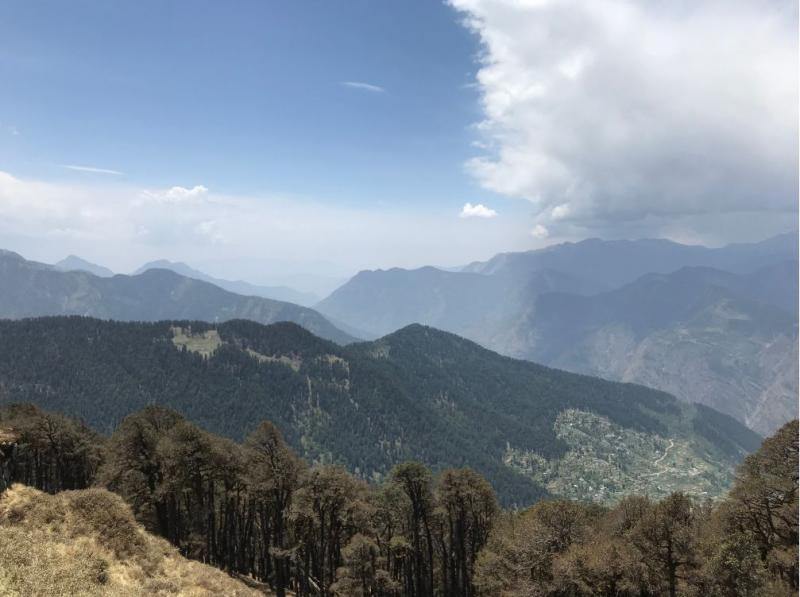
The Village of Salud in the distance, from where shepherds migrate up to the bugyals every summer.
The Village of Salud in the distance, from where shepherds migrate up to the bugyals every summer.
Photograph by Nivedita Nath
 This work is licensed under a Creative Commons Attribution 4.0 International License.
This work is licensed under a Creative Commons Attribution 4.0 International License.
Even though the Karyalaya’s projects were not fully realized, the Tehri Durbar’s move towards the mass plantation and processing of herbs risked dispossessing grazers from meadows, as well as eliding local knowledges related to jadi butiyan. The story of the Vanaspati Karyalaya arguably suggests how complex cultural associations between the Himalayas and healing were becoming commodified.
Archival Sources
- Indian States Administration Reports: Tehri Garhwal State, 1909–29, IOR/V/10/2023, British Library, London.
- The Annual Administration Report of Tehri-Garhwal State for the Year, 1932–1933, IOR/V/10/2024, British Library, London.
- The Annual Administration Report of Tehri Garhwal State, 1933–1939, IOR/V/10/2025, British Library, London.
- Dey, Kanny Lall. The Indigenous Drugs of India: Short Descriptive Notices of the Principal Medicinal Products Met with in British India. Calcutta: Thacker, Spink and Co., 1896.
- Osmaston, Arthur E. A Forest Flora for Kumaon. Allahabad: Government Press, 1927.
- Schlich, William, ed. The Indian Forester; A Quarterly Magazine of Forestry. Vol. 1 (1875–76). Calcutta: Central Press, 1876.
How to cite
Nath, Nivedita. “Histories of Central Himalayan Herbs: Vanaspati Karyalaya in Tehri Princely State c. 1879–1950.” Environment & Society Portal, Arcadia (Spring 2020), no. 13. Rachel Carson Center for Environment and Society. doi.org/10.5282/rcc/9018.
ISSN 2199-3408
Environment & Society Portal, Arcadia
 This work is licensed under a Creative Commons Attribution 4.0 International License.
This work is licensed under a Creative Commons Attribution 4.0 International License.
2020 Nivedita Nath
This refers only to the text and does not include any image rights.
Please click on an image to view its individual rights status.
- Aali-Bedini-Bagzi Bugyal Sanrakshan Samiti vs. State of Uttarakhand and Others, Writ Petition (PIL) No. 123 of 2014. Uttaranchal High Court, 21 August 2018. Indian Kanoon, http://indiankanoon.org/doc/147330564/.
- Dabral, Shiv Prasad. Uttarakhand ka Itihas. Vol. 6. Dogadda: Veer Gatha Press, 1976.
- Guha, Ramachandra. The Unquiet Woods. Delhi: Oxford University Press, 1989.
- Hardiman, David. “Indian Medical Indigeneity: From Nationalist Assertion to the Global Market.” Social History 34, no. 3 (2009): 263–83.
- Kumar, Anil. “The Indian Drug Industry under the Raj, 1860–1920.” In Health, Medicine, and Empire: Perspectives on Colonial India, ed. Biswamoy Pati and Mark Harrison, 356–85. Delhi: Orient BlackSwan, 2001.
- Pant, Pushpesh, and Chandi Prasad Bhatt. “A Conversation with Chandi Prasad Bhatt.” India International Centre Quarterly 38, no. 2 (2011): 108–21.
- Saklani, Atul. The History of a Himalayan Princely State. Delhi: Durga Publications, 1987.


